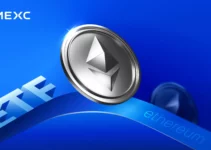
In crypto, price charts often steal the spotlight. Bitcoin breaking above $70,000, Ethereum gas spiking, or altcoins making 100% runs, these dominate headlines. But behind the scenes, a quieter, steadier player is shaping market sentiment: stablecoins.
Stablecoins aren’t flashy, but they are the backbone of liquidity in the digital asset ecosystem. By tracking net flows, volumes, and funding rates, traders can get a clearer read on risk appetite, capital movements, and even where the next breakout may come from.
Let’s unpack how stablecoin data works, what it tells us, and where MEXC fits in this picture.
1.Why Stablecoins Matter
Stablecoins like USDT, USDC, and DAI are designed to maintain a peg (usually $1), offering a safe harbor in volatile markets. Their role is threefold:
- Liquidity: Most trading pairs on exchanges use stablecoins as the base asset.
- On/Off Ramps: They act as bridges between traditional finance and crypto.
- Market Sentiment: Movements of stablecoins often precede market trends.
For example, when large amounts of USDT flow into exchanges, it’s often a bullish signal — capital is ready to buy risk assets. Conversely, stablecoins leaving exchanges can point to cautious sentiment, with traders sitting on the sidelines.
2.Key Metrics to Watch
- Stablecoin Net Flows
Net flows measure how much stablecoin is moving into or out of exchanges.
- Inflow Spike → Traders are preparing to buy crypto assets.
- Outflow Spike → Capital is exiting, often signaling profit-taking or caution.
Example: In mid-2024, before Bitcoin’s breakout to $68K, on-chain data showed $1.2 billion in USDT inflows to major exchanges within 48 hours. Days later, BTC surged as that dry powder deployed.
3.Trading Volumes
Stablecoin trading volumes show how active the market is.
- Rising Volumes: Indicate growing participation, whether bullish or bearish.
- Declining Volumes: Suggest lower conviction or a wait-and-see mood.
Stablecoin volumes are particularly important during consolidation phases (like BTC hovering around key levels). If volumes build up, it may foreshadow a sharp breakout in either direction.
4.Funding Rates (in Futures Markets)
Funding rates are periodic payments between long and short traders in perpetual futures markets.
- Positive Funding Rate: Longs are paying shorts → bullish sentiment.
- Negative Funding Rate: Shorts are paying longs → bearish sentiment.
Stablecoins are the margin currency in many futures markets, so when funding rates spike, it tells us how aggressively traders are positioning with their stablecoin collateral.
Example: In August 2025, ETH funding rates hit +0.08% (above the neutral range of ±0.01%). This signaled overheated long positioning, and ETH retraced shortly after.
5.Putting the Data Together
Watching these three indicators together paints a full picture:
| Metric | Bullish Signal | Bearish Signal |
| Net Flows | Stablecoins moving into exchanges → fresh buying power | Stablecoins flowing out of exchanges → sidelined capital |
| Volumes | Rising volumes → conviction & activity | Dropping volumes → lack of interest, potential chop |
| Funding Rates | Neutral/positive but not extreme → healthy long positioning | Excessively positive → over-leverage, risk of pullback |
When all three align, the signals become much stronger.
6.Case Study: BTC’s Summer 2025 Consolidation
During July–August 2025, Bitcoin consolidated between $65,000 and $70,000. Headlines debated: was this accumulation or exhaustion? Stablecoin data gave the answer:
- Net Flows: $800M+ USDT inflows to exchanges across two weeks → capital prepping for buys.
- Volumes: Rising USDT and USDC volumes indicated steady liquidity.
- Funding Rates: Stayed neutral, showing balanced positioning.
Sure enough, in early September, BTC pushed above $71K, confirming accumulation rather than weakness. Traders who tracked stablecoin signals had an early edge.
7.Where MEXC Fits In
At this point, you may ask: “Okay, this data is useful, but how does it tie back to my trading on MEXC?”
Here’s where MEXC provides value:
7.1 Deep Stablecoin Liquidity
MEXC offers deep liquidity on USDT and USDC pairs across spot and futures. This ensures smoother execution and minimal slippage when acting on stablecoin signals.
7.2 Data-Driven Insights
Through MEXC Learn and market dashboards, traders can track funding rates, volumes, and open interest directly — no need for external tools.
7.3 Futures Trading Edge
With 0.00% maker and 0.01% taker fees on futures, MEXC makes it easier to act on signals without costs eating into profits.
7.4 Stablecoin Earn Products
MEXC Earn allows you to park idle stablecoins in flexible/fixed savings products, earning passive yield while waiting for market signals to play out.
8.The Broader Picture
Stablecoin data doesn’t just guide short-term trades; it reflects broader narratives:
- Regulation: USDC adoption in Europe signals institutional integration.
- Market Cycles: Rising stablecoin dominance often precedes bull runs.
- Risk Appetite: High funding rates + stablecoin inflows often coincide with speculative rallies.
As crypto matures, stablecoins will continue acting as the pulse of the market. By reading their flows, volumes, and funding activity, traders can stay one step ahead.
9.Final Thoughts
If you only track BTC price, you’re looking at the surface. Stablecoins are the undercurrent that tells the real story.
By watching net flows, trading volumes, and funding rates, traders can gauge when capital is rotating in, when markets are overextended, and when to deploy or sit tight.
And with MEXC providing deep liquidity, data tools, and low-cost trading, it’s the perfect platform to put those insights into action.
So next time you see Bitcoin consolidating or ETH trending sideways, don’t just stare at the chart. Check the stablecoins, they’re whispering the market’s next move.
Disclaimer: This content is for educational and reference purposes only and does not constitute any investment advice. Digital asset investments carry high risk. Please evaluate carefully and assume full responsibility for your own decisions.
Join MEXC and Get up to $10,000 Bonus!



